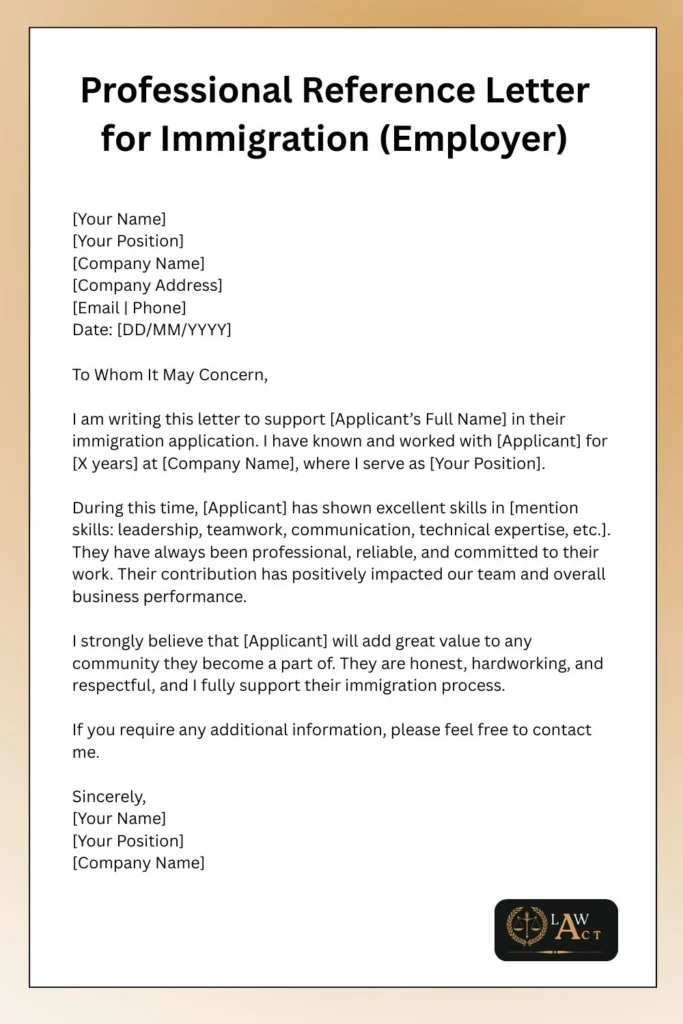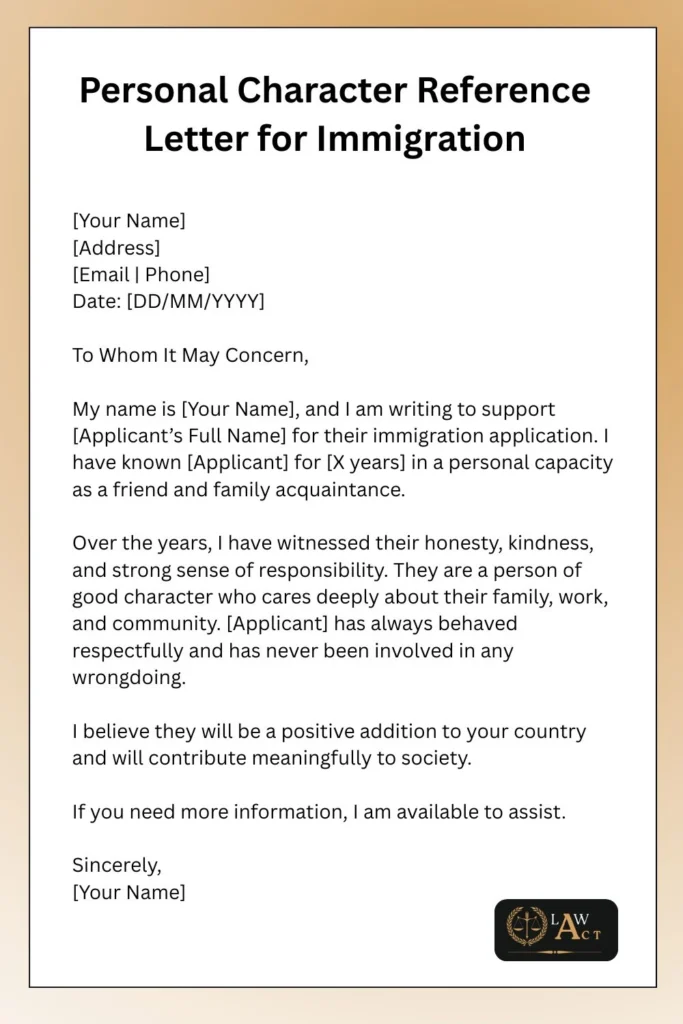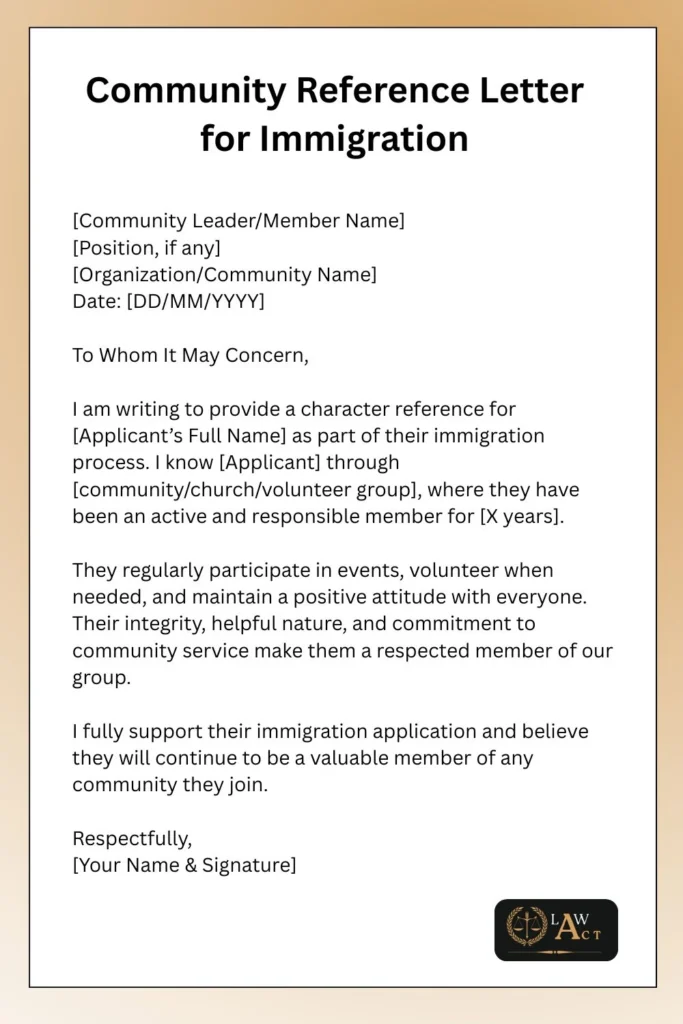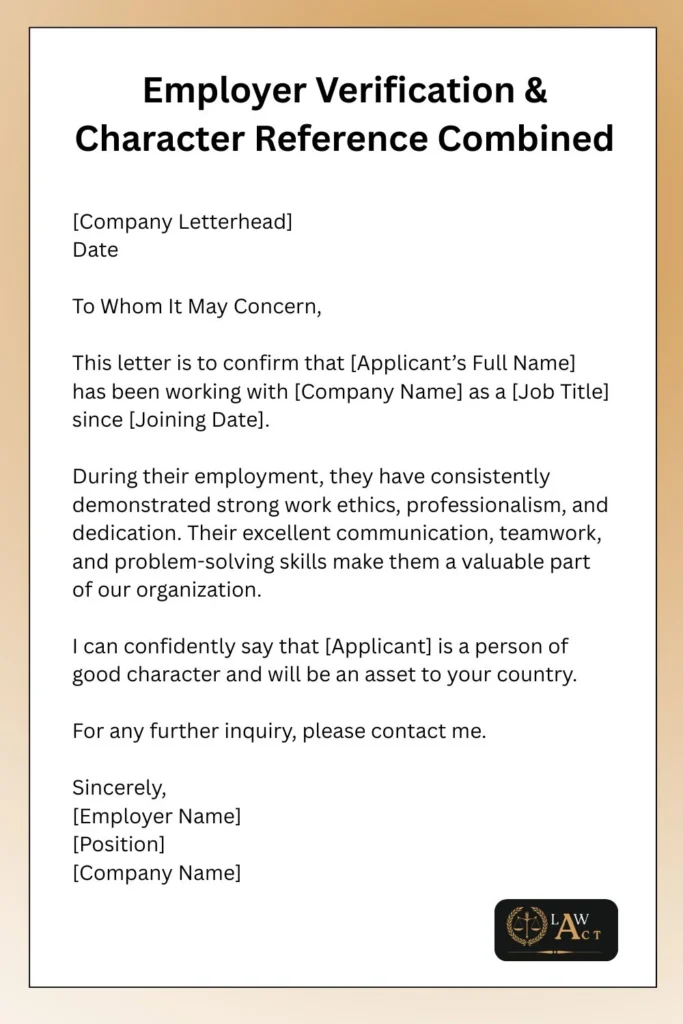If you know someone who is applying for immigration and you’ve been asked to write a reference letter for them, you might be wondering what exactly to include. A reference letter for immigration is a document written by someone who knows the applicant well and can vouch for their character, work ethics, and overall suitability to live in a new country. This type of letter can play an important role in the immigration process.
We will guide you through everything you need to know about writing a reference letter for immigration, including the proper format, tips, and even a sample. We will explain it in very simple words so that anyone can understand and use this guide easily.
What is a Reference Letter for Immigration?
A reference letter for immigration is also known as a character reference letter. It is written by a person who knows the immigration applicant personally or professionally and can provide information about their qualities, behavior, and values.
The purpose of the letter is to show that the person applying for immigration is a good and responsible individual who will be a positive addition to the country they wish to move to. This letter can be used as part of immigration cases for work permits, permanent residency, citizenship, or even refugee status.
Usually, this kind of letter is sent to immigration officers or lawyers handling the case.
Who Can Write a Reference Letter for Immigration?
This letter can be written by:
- A close friend
- A co-worker or employer
- A teacher or professor
- A community leader
- A religious leader (like a priest or pastor)
- A family member (in some cases, but not always preferred)
It is important that the person writing the letter (called the “referee”) knows the applicant well and can give real-life examples of their good behavior or contributions to the community or workplace.
Reference Letter Format for Immigration
Here is a simple sample letter for you to follow:

John Smith
123 Maple Street
Chicago, IL 60007
johnsmith@email.com
(123) 456-7890
April 20, 2025
To Whom It May Concern,
I am writing this letter in support of my friend, Mark Johnson, who is applying for permanent residency in the United States. I have known Mark for over eight years, and during this time, I have come to know him as a kind, hardworking, and respectful individual.
Mark and I met at our workplace, where we both worked as software developers. From the very beginning, Mark showed dedication to his work and was always ready to help others. He often stayed late to help his teammates and always kept a positive attitude.
Outside of work, Mark has also been very active in our local community. He volunteers at a food bank every weekend and helps organize events for underprivileged children. His selflessness and care for others are truly inspiring.
I strongly believe that Mark will be a great asset to any community or country. He follows the law, respects others, and is always willing to give back. I recommend him without any hesitation for immigration and permanent residency.
If you need any more information, feel free to contact me.
Sincerely,
John Smith
Professional Reference Letter for Immigration (Employer)

[Your Name]
[Your Position]
[Company Name]
[Company Address]
[Email | Phone]
Date: [DD/MM/YYYY]
To Whom It May Concern,
I am writing this letter to support [Applicant’s Full Name] in their immigration application. I have known and worked with [Applicant] for [X years] at [Company Name], where I serve as [Your Position].
During this time, [Applicant] has shown excellent skills in [mention skills: leadership, teamwork, communication, technical expertise, etc.]. They have always been professional, reliable, and committed to their work. Their contribution has positively impacted our team and overall business performance.
I strongly believe that [Applicant] will add great value to any community they become a part of. They are honest, hardworking, and respectful, and I fully support their immigration process.
If you require any additional information, please feel free to contact me.
Sincerely,
[Your Name]
[Your Position]
[Company Name]
Personal Character Reference Letter for Immigration

[Your Name]
[Address]
[Email | Phone]
Date: [DD/MM/YYYY]
To Whom It May Concern,
My name is [Your Name], and I am writing to support [Applicant’s Full Name] for their immigration application. I have known [Applicant] for [X years] in a personal capacity as a friend and family acquaintance.
Over the years, I have witnessed their honesty, kindness, and strong sense of responsibility. They are a person of good character who cares deeply about their family, work, and community. [Applicant] has always behaved respectfully and has never been involved in any wrongdoing.
I believe they will be a positive addition to your country and will contribute meaningfully to society.
If you need more information, I am available to assist.
Sincerely,
[Your Name]
Community Reference Letter for Immigration

[Community Leader/Member Name]
[Position, if any]
[Organization/Community Name]
Date: [DD/MM/YYYY]
To Whom It May Concern,
I am writing to provide a character reference for [Applicant’s Full Name] as part of their immigration process. I know [Applicant] through [community/church/volunteer group], where they have been an active and responsible member for [X years].
They regularly participate in events, volunteer when needed, and maintain a positive attitude with everyone. Their integrity, helpful nature, and commitment to community service make them a respected member of our group.
I fully support their immigration application and believe they will continue to be a valuable member of any community they join.
Respectfully,
[Your Name & Signature]
Reference Letter From Landlord for Immigration

[Landlord’s Name]
[Address]
[Phone | Email]
Date: [DD/MM/YYYY]
To Whom It May Concern,
This letter confirms that [Applicant’s Full Name] has been a tenant at [Property Address] from [Start Date] to [End Date/Present]. Throughout this time, they have always paid rent on time and maintained the property responsibly.
[Applicant] has been respectful, cooperative, and easy to communicate with. There have been no issues or complaints from neighbors or management.
Based on my experience, I can confidently say that [Applicant] is a responsible and trustworthy individual. I support their immigration application.
Sincerely,
[Landlord’s Name]
Employer Verification & Character Reference Combined

[Company Letterhead]
Date
To Whom It May Concern,
This letter is to confirm that [Applicant’s Full Name] has been working with [Company Name] as a [Job Title] since [Joining Date].
During their employment, they have consistently demonstrated strong work ethics, professionalism, and dedication. Their excellent communication, teamwork, and problem-solving skills make them a valuable part of our organization.
I can confidently say that [Applicant] is a person of good character and will be an asset to your country.
For any further inquiry, please contact me.
Sincerely,
[Employer Name]
[Position]
[Company Name]
Table Format of a Reference Letter For Immigration
It is important to follow a proper format when writing the letter. This makes it look professional and easier for immigration officials to read and understand. Here’s a table that shows the standard format of a reference letter for immigration:
| Part of Letter | What to Include |
|---|---|
| Header | Name, address, email, phone number (of the person writing the letter) |
| Date | The date when the letter is written |
| Salutation | Usually “To Whom It May Concern” or specific name if known |
| Introduction | Who you are, how you know the applicant, and for how long |
| Body Paragraphs | Talk about the applicant’s character, job, role in community, honesty, etc. |
| Real-life Examples | Add personal or professional examples that show good behavior or achievements |
| Closing Statement | Summary and recommendation of the applicant |
| Signature | Name and signature of the person writing the letter |
Common Mistakes to Avoid
- Writing too short letters
- Using overly emotional or informal language
- Not explaining the relationship properly
- Failing to give examples
- Forgetting to include your contact information
When is a Reference Letter Needed in Immigration?
There are several situations when a reference letter may be needed:
- When someone is applying for a green card or permanent residency
- During an application for citizenship
- For a work visa or student visa
- During court hearings related to immigration or asylum
These letters help the immigration authority understand the applicant as a person, not just as paperwork.
Should I Get the Letter Notarized?
While it is not always required, getting the letter notarized can make it more official. A notarized letter proves that the person who wrote it actually signed it and understands its content. If you’re not sure, it’s always a good idea to ask the immigration lawyer handling the case.
How Long Should the Letter Be?
Ideally, the letter should be 1 to 2 pages long. It should be detailed enough to show real support but not too long to lose interest. Each paragraph should give useful information.
Where to Submit the Letter?
The letter should be submitted along with the immigration application documents. The lawyer or immigration consultant can guide you where exactly it should go. Usually, it’s sent to USCIS in the U.S. or the proper government office in other countries.
Use of Formal Tone
Even though you might be writing the letter for a close friend or family member, always use a formal tone. Avoid using slang, emojis, or personal jokes. Think of it like writing a letter to a judge or official.
Final Thoughts
A well-written reference letter for immigration can make a big difference. It gives immigration officers a personal view of the applicant’s life, values, and personality. If you’re writing one, take your time, be honest, and use the format given in this blog. Always check the specific requirements of the immigration office or ask a lawyer if you’re unsure.
This letter can help someone build a new life in a new country. It is a big responsibility, but also a great way to support someone you care about.
Also Read:
- Different Consent Letter Formats
- Informal Letter Format
- Relieving Letter Formats: Everything You Need to Know
- Learn About Message Writing Formats
- Joining Letter Format: A Complete Guide
Frequently Asked Questions
What is a reference letter for immigration use?
A reference letter for immigration is a document written by someone who knows the immigration applicant and can vouch for their good character, behavior, and lifestyle. It helps immigration officers understand the applicant better as a person and shows that they can positively contribute to society.
Who can write an immigration reference letter?
Anyone who knows the person well can write it—like a friend, co-worker, boss, teacher, or community leader. They must have real experience with the applicant and be able to honestly share why that person should be allowed to live in the new country.
How long should a reference letter be?
A good immigration reference letter should be between 1 to 2 pages long. This is enough space to talk about your relationship with the applicant, their character, and to give examples. Don’t make it too short or too long. Keep it clear and honest.
What should I avoid in the letter writing?
Avoid lies, emotional stories with no facts, or very short letters. Also, don’t forget to mention how you know the person. Do not use jokes, emojis, or slang. Be serious but respectful. The letter must look professional and give clear examples of good behavior.
Do immigration letters need to be notarized?
Not always, but notarizing the letter adds extra trust. It shows that the person writing it signed it willingly and truthfully. If unsure, check with an immigration lawyer. Some immigration processes may prefer or require a notarized letter for added legal strength.



